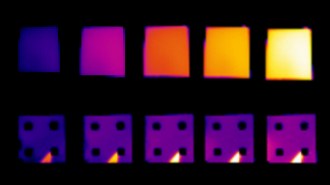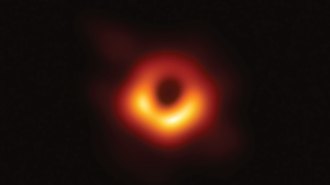Search Results

Coating Provides Infrared Camouflage
This guide, based on the Science News article “Coating provides infrared camouflage,” asks students to explore the physics and potential technological applications of a material, discuss the various types of electromagnetic radiation, analyze infrared images and research how infrared imaging is used across a range of fields.
Seeing in infrared
In this activity, students will analyze infrared images and then explore how infrared imaging is used across a range of fields of work. Skills include researching, evaluating, synthesizing and presenting information.
Exploring electromagnetic radiation
Students will watch a NASA video about the electromagnetic spectrum to learn about properties of the various types of radiation. Then, students will explore and discuss technologies that use specific types of electromagnetic radiation.
Hiding heat radiation
Students will answer questions about the Science News article “Coating provides infrared camouflage,” which explores the physics and potential technological applications of a material.

Saving Notre Dame’s Sound
This guide, based on the Science News article “Saving Notre Dame’s sound,” asks students to explore how scientists resurrect the acoustics of historic places, consider factors that affect how sound behaves to design a room with specific sound requirements, and measure and compare how sound changes in different environments.
A world of acoustics
Students will use decibel meters to understand how the volume of a sound changes as it travels away from a source. Concepts covered include sound waves, the inverse square law, absorption and reflection. The activity also asks students to consider how the characteristics of a space affect the sound.
Designing soundscapes
Drawing on their experiences with how sound behaves in different spaces, students will explore the engineering process by designing and sketching a room to meet specific sound requirements.
Sound science at Notre Dame
Students will answer questions about the Science News article “Saving Notre Dame’s sound,” which explores how scientists resurrect acoustics of historic places.
What’s that smell?
Students will explore how our sense of smell helps us interpret the world around us, and how those interpretations may vary. Students will practice analyzing data and determine how temperature affects vapor pressure and thus the intensity of scents.

2019 Year in Review
This guide, based on the biggest science stories of 2019 as reported by Science News, asks students to read and dissect a story of their choice and practice their summarizing skills. An activity from the Digital Library asks students to analyze and graph data about the moon’s orbit.
How to write a summary
Students will discuss what makes a good summary and practice their summarizing skills. After summarizing an article of their choice, students will share their summaries and get feedback from classmates. This exercise is based on Science News’ Top 10 stories of the year but can be used with any article.
Ten top science stories from 2019
Students will answer questions about one of Science News’ Top 10 stories of 2019.